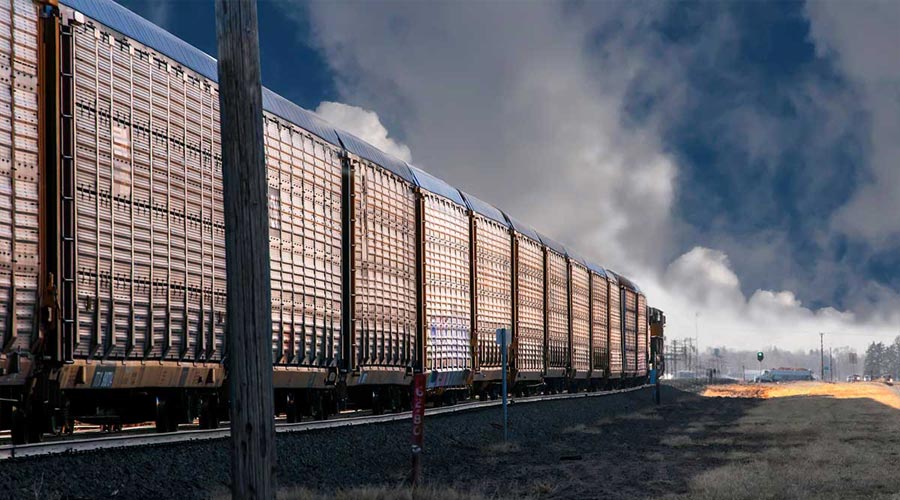Tallies, totals and other trend data in the freight transportation realm
7/24/2024
1.8
The shipments component of the Cass Freight Index was down 1.8% month over month in June "amid ongoing softness in for-hire demand," Cass Information Systems Inc. officials said on July 15. The index also fell 1.8% month over month in seasonally adjusted terms to a four-year low. "If there’s any silver lining, this is starting to look like a real bottom," Cass officials added.
2.24
FTR’s Trucking Conditions Index rose in May to 2.24 from the -1.95 reading for April "due to falling diesel prices and a freight rate environment that was less negative for carriers than has typically been the case over the past couple of years," FTR officials said on July 18. Added Avery Vise, FTR’s vice president of trucking: “Trucking is in the initial stages of a recovery, although it might be months before market participants perceive much change. ... We expect rates to be mostly stable overall through late this year with spot rates leading the way. However, the capacity overhang remains large and will delay anything that could remotely be called a rebound.”
4.5
FTR’s Shippers Conditions Index for May improved to 4.5 from April’s 3.0 reading, FTR officials said on July 24. Falling diesel prices "bolstered a favorable rate environment for shippers while other factors were only marginally favorable and mostly stable month over month," they said. "Our outlook for freight volume has strengthened a bit, putting at least some upward pressure on both capacity utilization and rates," added Avery Vise, FTR’s vice president of trucking. "However, shippers likely will see conditions that are more accurately characterized as neutral rather than negative. Ample capacity in trucking continues to discipline the freight market.”
5 & 31
For the quarter ended June 30, J.B. Hunt Transport Services Inc.'s intermodal unit reported segment revenue of $1.41 billion, down 5% compared with the same 2023 period, and operating income of $99.2 million, down 31%, J.B. Hunt officials said on July 16. Intermodal volume decreased 1% over the same period. "While experiencing some seasonal build in demand through the quarter, overall performance continued to be pressured by the soft freight market and its impact on over-the-road truck competition in the eastern network," officials said. "Segment gross revenue decreased 5% from the prior-year period, reflecting the 1% decrease in volume and a 5% decrease in gross revenue per load, resulting from changes in customer rates, fuel surcharge revenue, and the mix of freight. Revenue per load excluding fuel surcharge revenue decreased 4% year-over-year." The decrease in operating income was "primarily due to lower revenue, and higher insurance and claims, equipment-related, and certain personnel-related expenses," they said.
21
In May, Port Houston handled 364,866 twenty-foot equivalent units (TEUs), an increase of 21%, or more than 64,000 TEUs, compared with the same 2023 period, port officials said on June 21. From January through May, 1,758,960 TEUs moved through the port's two container terminals, a 14% increase compared with the same 2023 period. "Port Houston’s cargo volumes show no signs of slowing down despite any ongoing global supply chain disruptions," port officials said. "Robust construction of new warehouses and distribution centers the last two years and regional consumer spending on items like furniture, hardware, and retail goods have driven loaded import volumes to an increase of 18% this month compared to last year. Furthermore, strong manufacturing in Texas has pushed loaded exports, which increased by 21% this month, totaling 131,690 TEUs, and by 15% year-to-date through May, at 655,116 TEUs."
26.8
In June, full imports at the Port of Oakland increased 26.8%, to 84,040 TEUs compared with June 2023's total, the port's highest monthly total since August 2022, port officials said on July 17. “We are seeing promising signs from ocean carriers and importers, who are beginning to increase their inventories in preparation to meet holiday and year-end shopping demand,” said Port of Oakland Maritime Director Bryan Brandes. “The peak season usually begins in late summer to early fall, but this year it appears to be early. July is forecasted to ease a bit with the rest of the year continuing with strong volumes.”
41.1
The Port of Long Beach recorded its busiest June on record, moving 842,446 TEUs in June, up 41.1% from the same month last year and surpassing the previous record set in June 2022 by 7,034 TEUs, port officials said on July 16. Imports jumped 53% to 419,698 TEUs, exports rose 4% to 98,300 TEUs, and empty containers moving through the port increased 42.1% to 324,448 TEUs. “We are recapturing market share and consumer spending is driving cargo to our docks as we head into the peak shipping season,” said Port of Long Beach CEO Mario Cordero. “I see modest growth for the second half of 2024 as we strengthen our competitiveness and continue to invest in our rail infrastructure projects."
320,000
On July 17, MANA Nutrition leaders and employees hosted a groundbreaking ceremony to commemorate the development of a 320,000 square-foot warehouse in Pooler, Ga. Located four miles from the Port of Savannah, the facility will enable the company to double its current production while adding new storage capacity, Georgia Ports Authority officials said. Design-build firm A M King will transform the unfinished warehouse into an advanced food processing facility, which will open in first-quarter 2025 and produce MANA’s peanut butter-based product Ready-to-Use Therapeutic Food and Ready-to-Use Supplemental Food. The site will complement the company’s Fitzgerald, Georgia, production and storage facility.
50 million
The Southern California Association of Governments (SCAG) will receive $50 million for clean technology improvements, as part of a nearly $500 million grant for Southern California within $4.3 billion in investments to reduce pollution across the nation, the U.S. Environmental Protection Agency announced on July 22. SCAG’s Last Mile Freight Program — a partnership with the Mobile Source Air Pollution Reduction Review Committee to transition last-mile delivery vehicles to clean technologies — will receive $50 million of the nearly $500 million U.S. EPA funding award to support deployment of nearly 300 zero-emission fueling stations and up to 740 medium- and heavy-duty trucks.
1 billion
On July 12, the African Development Bank Group approved a $1 billion corporate loan to Transnet — South Africa’s sole operator of ports, railways and oil pipelines — for its recovery and growth plans. The 25-year loan will facilitate the first phase of the company’s ZAR 152.8 billion ($8.1 billion) five-year capital investment plan to improve its existing capacity, development bank officials said. Transnet has faced operational challenges in its rail and port businesses resulting from underinvestment in infrastructure and equipment, theft and vandalism, in addition to "external shocks" such as floods and the effects of the COVID-19 pandemic, development bank officials said. Transnet's recovery plan seeks to rehabilitate the infrastructure and accelerate the relaunch of operations over 18 months, focusing on restoring operational performance and freight volumes to meet customer demands, they added.
1.025 billion
UPS entered into an agreement to sell its Coyote Logistics business unit to third-party logistics firm RXO Inc. for $1.025 billion, UPS officials announced on June 23. "The decision to sell our Coyote Logistics business unit allows an even greater focus on our core business," said Carol B. Tomé, UPS' CEO.
42.2 billion
Growing at compound annual rate of 5.9% over the next 10 years, the global port equipment market will reach $42.2 billion in 2034, Transparency Market Research Inc. (TMR) predicts. Automation and digitalization will be a key role in the market's growth, TMR officials said in a July 23 press release announcing its findings. "As global trade expands, the demand for efficient, safe, and high-capacity port operations is increasing," they added. "Ports are required to handle larger volumes of cargo more quickly and reliably, necessitating the adoption of advanced equipment like cranes, forklifts, container handlers, and automated guided vehicles. These innovations streamline port activities, minimize delays, and enhance overall operational efficiency."
